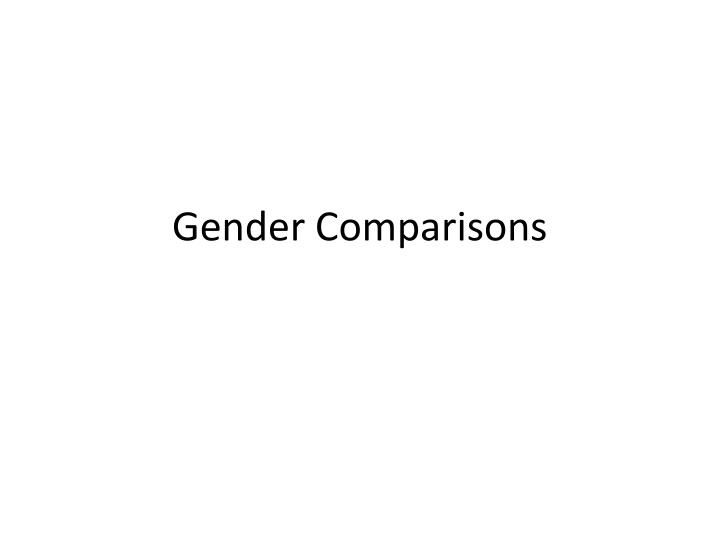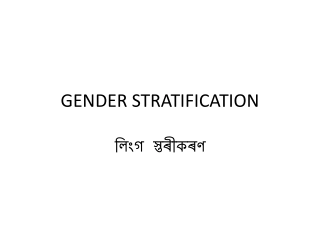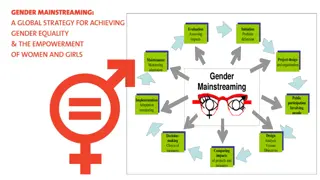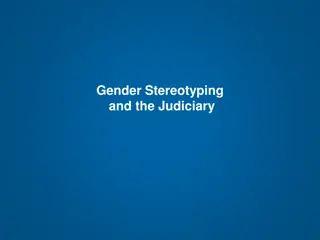Gender Comparisons
Biased samples in research on gender comparisons, influence of expectations, and the variability of gender differences in cognitive abilities are discussed. It highlights caution in interpreting research findings on gender disparities and suggests that such differences may not be as significant as often portrayed, especially in relation to career choices.
Download Presentation

Please find below an Image/Link to download the presentation.
The content on the website is provided AS IS for your information and personal use only. It may not be sold, licensed, or shared on other websites without obtaining consent from the author.If you encounter any issues during the download, it is possible that the publisher has removed the file from their server.
You are allowed to download the files provided on this website for personal or commercial use, subject to the condition that they are used lawfully. All files are the property of their respective owners.
The content on the website is provided AS IS for your information and personal use only. It may not be sold, licensed, or shared on other websites without obtaining consent from the author.
E N D
Presentation Transcript
Cautions About Research on Gender Comparisons Biased samples can influence results Almost all the research on cognitive abilities focuses on college students, so this research is not representative of the general population. We know almost nothing about adults who have not attended college. In addition, most of the research on gender comparisons examines White men and women in the United States and Canada. Our conclusions about gender comparisons might be different if these studies had included people of color.
Cautions About Research on Gender Comparisons People s expectations can influence results Biases can interfere at every stage of the research process. For example, researchers who expect to find gender differences will tend to find them. The participants also have expectations about cognitive gender differences.
Cautions About Research on Gender Comparisons Researchers seldom find gender differences in all situations. We cannot make general statements about gender differences. Instead, the gender differences often disappear when we test certain kinds of people or when we look at particular situations. This observation suggests that gender differences can be modified; they are not inevitable. In short, many males and females have remarkably similar psychological characteristics in many situations.
Cautions About Research on Gender Comparisons The cognitive gender differences are not large enough to be relevant for a person s career choice.
Gender Comparisons Cognitive Abilities
General Intelligence One major area in which females and males are similar is general intelligence, as measured by total scores on an IQ test. However, IQ scores for males show greater variability than IQ scores for females. Other research also shows gender similarities in general knowledge about history, geography, and other basic information. The media often claim that women are better than men at multitasking, or performing two tasks at the same time. However, researchers in cognitive psychology have not reported systematic gender differences in this area.
General Intelligence Complex Cognitive Tasks Males and females are equally competent when they form concepts and when they solve a variety of complex problems. Males and females are also similar in their performance on a variety of creativity tasks. You may have heard about gender differences in learning style with girls learning best in a cooperative environment and boys learning best in a competitive environment. However, researchers have not discovered gender differences in learning style.
General Intelligence Memory Ability In general, women are somewhat more accurate on memory skill. The research also shows that women tend to be more accurate than men in remembering events from their own lives. Women tend to be more accurate than men in recognizing faces. In general, women are also better than men in remembering objects that they have seen at an earlier time and also in remembering where they have seen these objects.
Verbal Ability Females score somewhat higher than males on a small number of verbal tasks, although the overall gender similarities are more striking. Some early research suggests that girls have larger vocabularies than boys have before the age of 2, but these gender differences disappear by 3 years of age.
Verbal Ability When we consider adolescents and adults, the research shows gender similarities in language skills such as spelling, vocabulary, word associations, reading comprehension, and learning a second language. However, females seem to be somewhat better at verbal fluency, or naming objects that meet certain criteria, such as beginning with the letter S.
Verbal Ability In a meta-analysis on overall gender comparisons in verbal ability, the average effect size (d) was only 0.11, just slightly favoring females. The research suggests that males are more likely than females to have language problems. For instance, school systems report reading disabilities about four or five times as often for boys as for girls. The term reading disability should refer to poor reading skills that are not accounted for by the level of general intelligence.
Verbal Ability Research shows that boys have more trouble focusing their attention, whereas girls are more skilled at controlling their behavior. It s likely that teachers target the more active, less attentive boys as having reading disabilities.
Verbal Ability An equally disturbing problem is that many girls probably have genuine reading disabilities, but they sit quietly in their seats and hide their disabilities. These well-behaved, neglected girls will miss out on the additional tutoring in reading that could help them thrive in school.
Mathematics Ability Media reports would lead you to expect large gender differences in math ability, favoring males. However, females and males in both the United States and Canada now complete the same number of math courses during high school. The results of the research on general math abilities make a clear statement about gender similarities in mathematics.
Mathematics Ability In fact, representative studies show that females earn higher grades in fifth-, sixth-, eighth-, and tenth-grade mathematics as well as in college math courses. Females also earn higher grades in related areas, such as high-school science courses and college-level statistics.
Mathematics Ability Females perform better when dealing with familiar situations, such as exams on material covered in a mathematics course. In contrast, males perform better when dealing with unfamiliar situations, especially the kinds of math problems included on the SAT. Studies pointed out that females high grades in math courses deserve wider publicity. This publicity would encourage females, their parents, and their teachers to be more confident about girls and women s competence in mathematics.
Spatial Ability Spatial abilities include understanding, perceiving, and manipulating shapes. Spatial ability plays a role in many everyday activities, such as playing electronic games, reading road maps, and arranging furniture in an apartment.
Spatial Ability Tasks that use spatial visualization require complex processing of spatially presented information.
Spatial Ability Many individual studies and meta-analyses have shown that males and females perform fairly similarly on tasks requiring spatial visualization. One component of spatial visualization is the ability to learn map information. Some studies find that males perform better, but other similar studies report no gender differences.
Spatial Ability In spatial perception tests, participants are asked to identify a horizontal or vertical location without being distracted by irrelevant information.
Spatial Ability Meta-analyses of gender comparisons for spatial perception show that males receive somewhat higher scores; effect sizes are in the range of 0.40. However, some studies report no gender differences on the water-level test.
Spatial Ability A test of mental rotation measures the ability to rotate a two- or three-dimensional figure rapidly and accurately.
Spatial Ability The mental rotation task produces the largest gender differences of all skills, when measured in terms of performance speed. Males tend to respond faster than females. Additional studies show that gender differences on mental rotation tasks depend on how the task is described to participants. Men performed much better than women when the instructions emphasized the usefulness of these spatial abilities in stereotypically masculine professions, such as piloting military aircraft. However, the gender differences disappeared when the instructions emphasized how these abilities could help in stereotypically feminine occupations, such as interior decoration.
Explaining the Gender Comparisons Biological Explanations It s ironic that the media and some researchers are extremely eager to embrace a biological explanation of gender differences, even though those differences are not well established. A genetic explanation suggests that spatial ability might be a recessive trait carried on the X chromosome. However, it s not clear how genetic factors would operate.
Explaining the Gender Comparisons Biological Explanations Hormones are critically important before birth and during puberty however, it s not clear how hormonal factors would operate. In addition, the results are often complex or contradictory.
Explaining the Gender Comparisons Biological Explanations The last category of biological explanations focuses on brain organization, specifically, the potential gender differences in brain lateralization. Lateralization means that the two halves (or hemispheres) of the brain function somewhat differently. In humans, the left hemisphere tends to be faster and more accurate on language tasks, and the right hemisphere tends to be faster and more accurate on spatial tasks.
Explaining the Gender Comparisons Biological Explanations A typical lateralization theory might argue that males use only the right hemisphere to perform spatial tasks. In contrast, females may use both hemispheres to perform all cognitive tasks. This approach argues that females work slowly on a spatial task because only a small portion of the right hemisphere is available to process this spatial information.
Explaining the Gender Comparisons Experience as an Explanation Let s consider how males and females differ in the amount of experience they have had with mathematics and spatial tasks. Males and females now take a similar number of math courses during high school. However, males are more likely to belong to a chess club, be members of a math team, learn about numbers in sports, and have more experience with computers.
Explaining the Gender Comparisons Experience as an Explanation Compared to girls, boys also have more experience with maps, videogames, and other spatial tasks. This additional practice helps boys perform a mental-rotation task relatively quickly and accurately. Parents and teachers may provide different experiences for males and females.
Explaining the Gender Comparisons Experience as an Explanation For example, parents spend more time explaining science concepts to their sons than to their daughters. The media seldom feature females in nontraditional situations. When elementary textbooks show how people use mathematics, they often include more pictures of boys than girls. The girls also appear primarily in helping roles.
Explaining the Gender Comparisons Attitudes as an Explanation Parents and teachers attitudes can influence their children s self-confidence indirectly. For instance, if parents and teachers hold strong stereotypes about females poor performance in math and science, they may convey these stereotypes to their daughters. By the age of 11 or even earlier boys often perceive themselves as more competent in math than girls do, even though boys may actually receive lower grades.
Explaining the Gender Comparisons Attitudes as an Explanation By about the age of 10, many students believe that math, computers, and science are primarily associated with males. Many females may avoid math because it seems too masculine. Stereotype threat may decrease females performance on mathematics and spatial tests.
Gender Comparisons Attitudes about Achievements
Attitudes about Achievements Achievement motivation, which is the desire to accomplish something on your own and to do it well. Many theorists have claimed that women are missing from certain prestigious fields because they have personal deficiencies that inhibit their achievement. However, the research actually shows that females are more likely than males to have positive attitudes toward school, spend time studying, earn higher grades Females are also less likely than males to drop out of school and more likely to enroll in college.
Achievement Motivation To measure achievement motivation, researchers often ask the study participants to look at drawings of people in various situations and then to createstories based on these drawings. A person receives a high achievement motivation score if these stories emphasize working hard and excelling.
Achievement Motivation The research, conducted with both Black and White participants, shows that males and females are similar in achievement motivation. Males and females are also similar in their intrinsic motivation, which is your tendency to work on a task for your own satisfaction, rather than for rewards such as money or praise. Furthermore, males and females are equally likely to emphasize motivation when they describe important events in their lives.
Confidence in Your Own Achievement and Ability Level of Self-Confidence Boys and girls may not differ significantly in their academic self-confidence. However, several studies suggest that men are more self-confident about their ability than women are. Researchers have found that gender differences in self-confidence are larger when people make public rather than private estimates.
Confidence in Your Own Achievement and Ability Level of Self-Confidence Women are especially likely to give low estimates for their grade-point average when another student has already announced that he or she has low grades. One possible explanation is that women are more likely than men to be modest when they are with other people. Gender differences in self-confidence tend to be larger on a task that is considered traditionally masculine, rather than one that is considered neutral or traditionally feminine.
Confidence in Your Own Achievement and Ability Level of Self-Confidence For students with strong stereotypes about gender differences in math ability, the boys overestimated their scores and girls underestimated their score. For students who believe in gender similarities in math ability, girls and boys provided similar estimates.
Confidence in Your Own Achievement and Ability Self-Confidence and Evaluation Provided by Others Men s self-confidence ratings were not significantly changed by the nature of the comments other people made. In contrast, the women s self-confidence rose dramatically after receiving positive comments, and it fell even more dramatically after receiving negative comments.
Confidence in Your Own Achievement and Ability Self-Confidence and Evaluation Provided by Others One reason is that women may be more likely than men to believe that other people s evaluations are accurate assessments of their performance. Furthermore, women may be more likely to use the information from these evaluations in assessing their own performance, even when the evaluations are not accurate.
Confidence in Your Own Achievement and Ability Personal Definitions of Success Women were somewhat more likely than men to emphasize a balance between professional achievement and personal relationships, rather than focusing primarily on their profession. Furthermore, men were more likely than women to emphasize material success.
Confidence in Your Own Achievement and Ability Attributions for Your Own Success Attributions are explanations about the causes of your behavior. When people have been successful on an achievement task, they often attribute that success to some combination of four factors: (1) ability, (2) effort, (3) task easiness, and (4) luck.
Confidence in Your Own Achievement and Ability Attributions for Your Own Success When people make judgments about men, they tend to attribute the success of men to their high ability. In contrast, when they make judgments about women, they tend to attribute the success of women to other factors, such as an easy task or luck.
Confidence in Your Own Achievement and Ability Attributions for Your Own Success When other people are around, men are more likely than women to credit their own ability. When men and women provide attributions in private, their responses are typically similar. Men are more likely than women to use the ability explanation on stereotypically masculine tasks such as earning high grades in mathematics. Similarly, women are more likely than men to use the ability explanation on stereotypically feminine tasks such as earning high grades in an English course.
Confidence in Your Own Achievement and Ability Attributions for Your Own Success However, when women are told that they earned a low score on a math test, they tend to attribute this poor performance to a lack of math ability. Between the ages of about 13 and 25, females and males tend to have similar attribution patterns. However, among people older than 25, men are more likely than women to say, I did well because I have high ability























